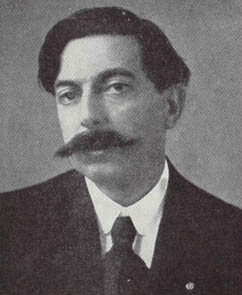Enrique Granados

Born: July 27, 1867 in Lérida [Catalan: Lleida], Spain
Died: March 24, 1916 at sea between New York and England
Piano Quintet in G Minor, Op. 49
- Composed: 1894–95
- Premiere: February 5, 1895 in Madrid with the composer as pianist
- Duration: approx. 18 minutes
Enrique Granados, born in 1867 into the family of an army officer in Lérida, near Barcelona, studied piano at the Barcelona Conservatory as a boy (he gave his first public concert at age 10) and Spanish music with the noted folklorist Felipe Pedrell. He went to Paris in 1887 to apply for admission to the Conservatoire, but he fell ill during the entrance examinations, and instead became a private student of Charles Wilfrid de Bériot, son of the famous contralto Maria Malibran and one of the Conservatoire’s most distinguished faculty members. Granados remained in Paris for two years before returning to Barcelona in 1889, where his mature debut the following year created a sensation and led to a successful performing career that took him throughout Europe as a recitalist, concerto soloist and chamber music player. The premiere in 1892 of orchestrations of three of his Spanish Dances, among the earliest works in the Spanish idiom written by a native musician, was well received and brought Granados his first acclaim as a composer. Such encouragement prompted him to carry on with the series, and, by 1900, he had completed and published a full dozen Spanish Dances.
Granados continued to concertize and compose during the first decade of the 20th century, concentrating on piano pieces and songs. In 1911, he wrote the music considered by many to be his masterpiece — a piano cycle titled Goyescas inspired by the paintings and tapestry cartoons of Francisco Goya. Granados premiered his Goyescas in Barcelona on March 9, 1911 and created enormous enthusiasm when he performed it at the Salle Pleyel in Paris on April 4, 1914. He was awarded the Légion d’honneur and given a contract by the Paris Opéra to create an operatic version of the keyboard suite for the coming season. The outbreak of World War I in August stymied the promised production in Paris, however, so the Metropolitan Opera in New York premiered the work in January 1916. On the voyage home from America, Granados’ boat was torpedoed by a German submarine on March 24, 1916. He was picked up by a lifeboat, but dived back into the frigid water to try to save his struggling wife. Both drowned. His death at the age of 48 robbed Spain of one of its greatest and most promising artists.
Granados composed both the Piano Quintet (Op. 49) and the Piano Trio (Op. 50) in Barcelona in 1894–1895, after he had returned home from his two years of study in Paris. Both works show the influences of Fauré, Brahms, Schumann and the other French and German composers he had absorbed in the city, before those sources were succeeded by the Spanish idioms and ethos that soon became central to his music. The Piano Quintet’s first movement, in a variant of traditional sonata form, opens with a main theme comprising a stern, four-note, unison motto followed by a triplet-rhythm motive presented both as a staccato scale and in lyrical phrases. In a time-honored process that traces to the quartets and symphonies of Franz Joseph Haydn, most of what follows is spun from this handful of motives. As a second theme, the lyrical triplet phrases are cast in a brighter key before the music pauses on a few soft, tentative chords and then launches into a development of the main theme’s motives, which culminates in a fugue. This passage builds to a climactic moment that leads to an altered recapitulation of the movement’s principal motives and an emphatic close. The Allegretto is based on a wistful strain that evokes a simple melody played by a lonely shepherd on his pipe; the movement’s flowing central episode is in the character of a lullaby. Following the return of the shepherd’s song, the movement closes with a reminiscence of the lullaby. In the finale, the returns of the main theme — a fiery strain reminiscent of Hungarian Romani music — are countered by lyrical episodes of slightly melancholy cast.
—Dr. Richard E. Rodda